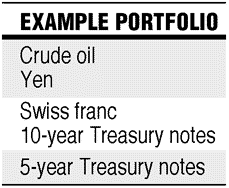MONEY MANAGEMENT
Sizing A Futures Trading Account
by Jay Kaeppel
While most traders start out working on a trading system, they forget that the amount of starting capital is equally important. Here are some guidelines to consider.

Before a trader can start trading a portfolio of different contracts, he or she should determine how much capital is needed. Unfortunately, topics such as sizing an account tend to be an afterthought for most new traders -- until, that is, they suffer a drawdown of frightening or ruinous proportions.FIGURE 1: EXAMPLE PORTFOLIO. The example system involves trading a portfolio of one contract each of five different futures markets using the same mechanical trading system. This system uses a moving average crossover approach for entry and exit, and no stops are used. The markets to be traded can be seen here.
THREEFOLD DANGER
The dangers in failing to size an account properly are threefold: The first and greatest danger is that you might tap out (that is, lose all your money). Consider the naive trader who opens an account with $20,000 and begins trading a group of markets using the trading system he spent hundreds of hours developing. While the trader has total confidence in the buy and sell signals generated by the system, he fails to do enough homework regarding expected equity swings. He doesn't know that the portfolio/system combination routinely experiences equity swings of $15,000. Of course, he could get lucky, start making money right off the bat, and then be able to sit through a subsequent $15,000 drawdown. It's more likely, however, he will suffer a $15,000 drawdown at some point and stop trading altogether because he was not prepared financially for the huge percentage swings in equity.
The second risk is you suffer a drawdown that is such a large percentage of your trading account you may feel compelled to stop trading, which eliminates all possibility of recouping your loss. The third risk, at the other end of the spectrum, involves opportunity cost. If you put $1 million into a trading account to be overcapitalized but then trade a portfolio that only generates a 5% annual return, you have cost yourself the opportunity to profit in other ways.
The key to avoiding these risks is to properly capitalize your trading account. To do so, you must have some idea of what to expect from your portfolio in terms of profits and drawdowns, and you must also make the critical determination as to the type of return you seek and whether you can stomach the risks involved.